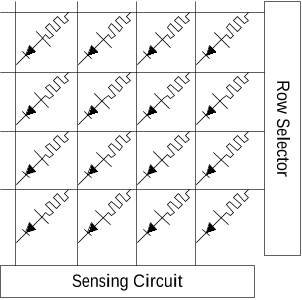Memristor-based memory
Reads0
Chats0
TLDR
The read operation of memristor-based memories is investigated and a new technique for solving the sneak paths problem by gating the memory cell using a three-terminal memistor device is introduced.About:
This article is published in Microelectronics Journal.The article was published on 2013-02-01 and is currently open access. It has received 378 citations till now. The article focuses on the topics: Memristor & Memistor.read more
Figures

Figure 1: A simple memristor-based memory array showing how a memristor device is located at the intersection between two bars of the array. 
Figure 10: Simple memory array showing the added column capacitors for the AC sense. 
Figure 9: Simple memory array with 1D1M used for each memory cell. ![Table 1: Detailed comparison between memristor-based memory, traditional memories, and other emerging memories according to the 2011 ITRS report [1]. The abbreviations used are: T – transistor, C – capacitor, R – resistor, and D – diode. The bold font indicates the best value per row.](/figures/table-1-detailed-comparison-between-memristor-based-memory-1jvhbfr7.png)
Table 1: Detailed comparison between memristor-based memory, traditional memories, and other emerging memories according to the 2011 ITRS report [1]. The abbreviations used are: T – transistor, C – capacitor, R – resistor, and D – diode. The bold font indicates the best value per row. 
Figure 11: Examples of different organizations with different aspect ratios for a 16-cell memory array. 
Figure 12: Noise margin (∆′) versus aspect ratio for different array sizes.
Citations
More filters
Journal ArticleDOI
Nanoscale resistive switching memory devices: a review.
TL;DR: The suitability of the different device concepts for beyond pure memory applications, such as brain inspired and neuromorphic computational or logic in memory applications that strive to overcome the vanNeumann bottleneck, is discussed.
Journal ArticleDOI
TiO2-based memristors and ReRAM: materials, mechanisms and models (a review)
TL;DR: In this paper, the state-of-the-art for resistive random access memory (ReRAM) and memristor nonvolatile memory (MIMO) is summarized.
Journal ArticleDOI
A Memristive Multilayer Cellular Neural Network With Applications to Image Processing
TL;DR: A novel memristive multilayer CNN (Mm-CNN) model is presented along with its performance analysis and applications, which has several merits, such as compactness, nonvolatility, versatility, and programmability of synaptic weights.
Journal ArticleDOI
Low-power linear computation using nonlinear ferroelectric tunnel junction memristors
Radu Berdan,Takao Marukame,Kensuke Ota,Marina Yamaguchi,Masumi Saitoh,Shosuke Fujii,Jun Deguchi,Yoshifumi Nishi +7 more
TL;DR: In this article, a nonlinear ferroelectric tunnel junction memristors can be used to perform linear vector-matrix multiplication operations at ultralow currents and achieve energy efficiencies above 100 tera-operations per second per watt.
Journal ArticleDOI
Stochasticity Modeling in Memristors
TL;DR: The model proposed is generic and could be incorporated into variants of threshold-based memristor models in which apparent variations in the output hysteresis convey the switching threshold shift, and paves the way for novel approaches in the fields of neuromorphic engineering circuits design.
References
More filters
Journal ArticleDOI
The missing memristor found
TL;DR: It is shown, using a simple analytical example, that memristance arises naturally in nanoscale systems in which solid-state electronic and ionic transport are coupled under an external bias voltage.
Journal ArticleDOI
Memristor-The missing circuit element
TL;DR: In this article, the memristor is introduced as the fourth basic circuit element and an electromagnetic field interpretation of this relationship in terms of a quasi-static expansion of Maxwell's equations is presented.
Journal ArticleDOI
Nanoscale Memristor Device as Synapse in Neuromorphic Systems
TL;DR: A nanoscale silicon-based memristor device is experimentally demonstrated and it is shown that a hybrid system composed of complementary metal-oxide semiconductor neurons and Memristor synapses can support important synaptic functions such as spike timing dependent plasticity.
Journal ArticleDOI
Resistance Switching Memories Are Memristors
TL;DR: The memristor is a 2-terminal nonvolatile memory device that exhibits a pinched hysteresis loop confined to the first and third quadrants of the v-i plane whose contour shape in general changes with both the amplitude and frequency of any periodic sine-wave-like input voltage source, or current source as mentioned in this paper.
Resistance Switching Memories are Memristors.
TL;DR: The goal of this tutorial is to introduce some fundamental circuit-theoretic concepts and properties of the memristor that are relevant to the analysis and design of non-volatile nano memories where binary bits are stored as resistances manifested by the Memristor’s continuum of equilibrium states.